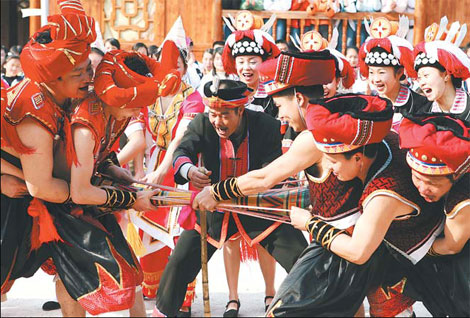
Members of the Yao ethnic group taking part in a traditional sport. Provided to China Daily
Guangxi has a large number of ethnic groups and wants to improve its people's lives and increase unity among them.
In the first year of the 12th Five-Year Plan (2011-2015), the region is placing priority on social security, employment, balanced development in different areas, and the role of non-governmental organizations in social affairs to improve the people's lives, Gao Xiong, vice-chairman of the autonomous region, remarked at a meeting in March.
Guangxi will spend 880 million yuan ($135.7 million) in 2011 in renovating old houses, improving safe drinking water, and building roads. Last year, it spent 1.02 billion yuan improving the quality of life of workers, solving housing problems and helping provide safe drinking water to 27,390 farm families.
Guangxi has suffered from natural disasters in the past five years, such as severe droughts and floods.
With an improved disaster relief and emergency management system, the region has been able to solve the housing, clothing and food problems of many victims. It has given assistance to 17.78 million victims and has rebuilt 457,900 houses.
During that same time, the social security system operated efficiently and the needy got help in time. The relief funds amounted to more than 8 billion yuan, over the five-year period.
Guangxi emphasizes unity and harmony among its 12 ethnic groups, which include the Zhuang, Yao, Miao, Dong, Jing, Yi and Shui. The ethnic population is around 19.5 million, or 38.3 percent of the region's total.
Among the Party and government leaders at or above the county level, 43.5 percent are from ethnic groups, or 5.2 percentage points higher than the ethnic group's portion of the total population.
The region has also spent heavily on primary and middle schools for ethnic groups to improve their basic education level.
It has spent more on the Guangxi University for Nationalities to train people for the social and economic development of the region. The improved education of ethnic groups has helped provide talented people to help with ethnic unity and harmony.
Cultural facilities are provided for ethnic groups, including museums, culture palaces, art centers, and cinemas. In addition, the region has organized traditional sports events among these groups.

Popular Videos
Hot comments
- First apes at U.S. zoo receive COVID-19 vaccine made for animals, zoo official says
- China Life: Chinese women shine with She Power
- Foreign firms approved to offer VPN services in capital
- Homemade curling videos trending in China
- 86-year-old grandma in Hebei spends most her life on traditional cheongsam
- Winners of 2022 Inaugural WLA Prize announced
- Lantern Festival: A romantic celebration in China
- Two Chinese COVID-19 vaccine firms to supply vaccines to COVAX
- Media center for 20th CPC national congress to open on Oct. 12
- Six suspects arrested in HK for role in SE Asia job scam
Top Reviews
- Young artists recreate beauty of traditional Hanfu costume
- China releases photos of tallest tree
- English version of ‘Understanding Xi Jinping’s Educational Philosophy’ published
- China crowned in men’s team for 10th straight time at table tennis worlds
- China publishes Atlas of Wildlife in SW China
- Guangxi’s 10 Years: A Visit to China’s Qinzhou Port
- Congress delegate helped lift village out of poverty
- Expo highlights joint efforts in NEV development
- Racism stain of shame on ‘world democratic paradise’
- U.S. may face new COVID wave this upcoming winter: report







